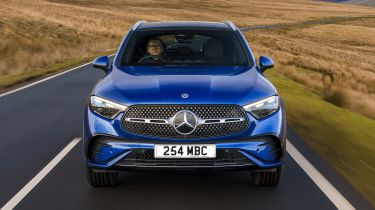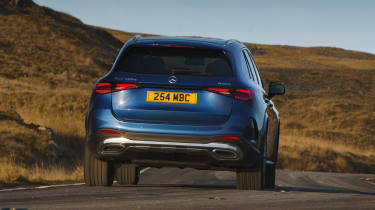Mercedes GLC review - Engines, performance and drive
The GLC has a decent range of 2.0-litre engines with some excellent hybrid options

The Mercedes GLC uses the same platform as the C-Class saloon and estate, and so it shares engines with that model as well. Unlike the C-Class the GLC uses four-wheel drive as standard – all models come with Mercedes’ 4MATIC set-up and a nine-speed automatic gearbox.
The gearbox is smooth and shifts quickly enough – it’s a match for the units in any of its rivals and the hybrid versions’ electric motors mean they’re even more relaxing to drive as the gearbox doesn’t even have to shift at low speeds when the engine isn’t even running.
There are two versions of the GLC that have a full plug-in hybrid setup: the GLC 300e and GLC 300de. The 300e is the petrol version and it uses a 254bhp 2.0-litre petrol engine along with a 134bhp electric motor, while the 300de uses a diesel motor with 194bhp and the same electric motor.
Outside of the plug-in models, the range includes the GLC 220d (a 194bhp diesel), the GLC 300d (a 265bhp diesel) and the GLC 300 (a 254bhp petrol). There are no six-cylinder models – all are 2.0-litre four-cylinder engines and so aren’t the most luxurious-feeling motors, but they are quiet and smooth enough.
Used - available now
The GLC 300 has 400Nm of torque, the 300d has 550Nm and the others all have 440Nm, so every version of the SUV feels pretty muscular. There’s certainly enough punch in even the entry-level models, so you don’t need to worry about any version of the GLC feeling underpowered.
Sadly, the GLC’s ride and handling is underwhelming. While the engine and transmission in the versions we’ve tried so far have been impressive, the vague steering, body roll in corners and inconsistent brake pedal feel were disappointing. The large alloy wheels crash into bumps and create a rather lumpy ride that isn’t fitting for a family car, let alone a Mercedes SUV. We’d certainly stick to the smaller wheel options.
The BMW X3 and Jaguar F-Pace are more fun to drive while also being more comfortable than the Mercedes, while the Volvo XC60 is just as refined but more comfortable over bumps.
0-62mph acceleration and top speed
The GLC 300 is the quickest version in the regular GLC range, as it goes from 0-62mph in 6.2 seconds and has a top speed of 149mph. Other versions are very close behind: the 300d takes 6.3 seconds to do the same benchmark sprint and gets to 151mph, while the plug-in hybrid GLC 300de takes 6.4 seconds to get to 62mph and can reach 135mph.
The GLC 300e plug-in does 0-62mph in 6.7 seconds and can also reach 135mph, while both plug-in versions have a top speed of 87mph in electric-only mode. The slowest model in the range right now is the GLC 220d, which takes eight seconds to reach 62mph and hits a top speed of 136mph. This is still more than good enough for any family car, though, so the GLC range has plenty of performance.
If you want a more potent version of the Merc's mid-size premium SUV, the 415bhp GLC 43 and 671bhp GLC 63 S E Performance from Mercedes' AMG division have been unveiled and are expected to hit the streets later in 2023. The GLC 43 will hit 62mph in 4.8 seconds and top out at a limited 155mph top speed, while the plug-in hybrid GLC 63 S E Performance goes from 0-62mph in just 3.5 seconds and will hit 171mph given enough road.














